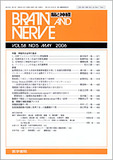Japanese
English
- 有料閲覧
- Abstract 文献概要
- 1ページ目 Look Inside
- 参考文献 Reference
要旨 目的:従来の視野測定が困難である1例の脳梗塞患者において,多局所視覚誘発電図(multifocal visual evoked potentials : mVEP)を測定することにより他覚的に視機能の評価が可能であるかを検討した。
方法:VERIS Junior Scienceを用いて,51歳から72歳までの正常被験者20例に対してmVEPの測定を行い,頂点潜時と振幅を評価の対象とした。さらに,1例の脳梗塞患者に対してmVEPを施行し,画像的に認められた脳梗塞領域と比較した。
結果: 正常被験者から得た各象限における反応波形は,耳側と鼻側では類似した波形が認められ,上半視野と下半視野において極性が反対である波形が認められた。脳梗塞患者においては頭蓋内病変に一致してmVEPでも波形の異常を認めた。
結語:mVEPを用いた他覚的な視野障害の評価は,視野計測が困難な脳梗塞患者においても有用であると思われた。
Purpose :We investigated whether visual field defects can be objectively evaluated using multifocal visual evoked potentials(mVEP)in a patient with cerebral infarction in whom it is difficult to measure the visual field.
Methods : To determine normal waves in mVEP, recording was performed using a VERIS Junior Science (Mayo, Aichi, Japan) in 20 healthy subjects (20 eyes), peak latency and amplitude were used for assessment. In a patient with cerebral infarction, mVEP were recorded, and compared with the lesion observed by computed tomography.
Results : In 20 healthy subjects, the waveforms in the nasal and temporal quadrants were very similar but the waveforms in the superior and inferior quadrants were mirror images. The mVEP in patient with cerebral infarction showed abnormal waves, corresponding to the visual field defects in the lesion observed by computed tomography.
Conclusions : Objective evaluation of visual field defects using mVEP may be useful in patients with cerebral infarction in whom kinetic/static perimetry as a subjective examination is difficult.

Copyright © 2006, Igaku-Shoin Ltd. All rights reserved.


